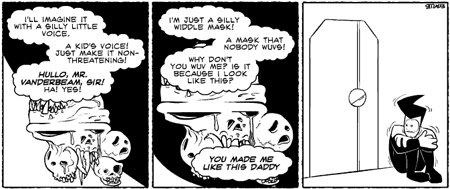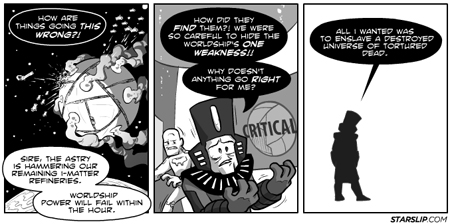 I’ve long been impressed by Starslip Crisis.
I’ve long been impressed by Starslip Crisis.
It has always had exceptional production values – clean art, reliable updates, a strong focus and engaging characters. It started out as a strip about the Starship Fuseli, a museum (in space!), and the quirky group on board – a pretentious curator as captain, an ex-pirate as the pilot, and a strangely-innocent insectoid alien as the staff. Plenty of room for humor, and that was the core focus for quite some time – and the strip continues to deliver that to this day, with a punchline in (almost) every four-panel strip. Kris Straub’s previous work, Checkerboard Nightmare, certainly got solid attention in the webcomic community – but I think Starslip is really where he hit his full stride, and delivered a masterwork.
But while the initial comic was well-crafted and had a definite degree of charm, what really made it stand out was when it began to truly develop those characters… and the story itself began to take on more epic concerns. The name of the comic – Starslip Crisis – came to full meaning when it was revealed that the commonly used method of space transportation (‘starslipping’) had certain… problems. It turns out that tapping into parallel universes for your own personal convenience is never a good plan.
Events build from there. The humble crew of the Fuseli has to confront insane space tyrants, the greed-driven corporations that run the government, and an army of space-cops from the future. There was excitement, there was sorrow, there was conflict – all remarkably well-executed, all entertaining to watch.
But… over the last year or so, the focus started to drift. The cast was split between several locations, and the standard interplay between the characters – which, honestly, was really at the heart of the strip – was lost. There were plenty of good moments during this time – I consider the tale of the Dreadmask to be among the funniest moments in the strip. But while Straub’s humor continued to hit the mark, the strip’s current state left him with several challenges. The storyline had gotten more and more convulated – it remained remarkably straightforward for anything dealing with time-travel and parallel timelines, but that was still complex enough to present a hurdle for new readers.
The strip had started with a wonderfully simple premise: “A museum in space.” Now, how many words would it take to describe the comic? There was no longer a single focus, nor even a single location or cast the comic was built around. Even the plot itself presented a hurdle – the present had gone to war with the future, and reached a bitter stalemate. One side didn’t have the power to hurt the other; the other side didn’t dare risk using their power for fear of wrecking their own past. How do you resolve that? Finding an answer to that dilemma was challenge enough alone.

Memnon's flair for the dramatic is often played for laughs - but sometimes, that eloquence is the only thing suitable for the occasion.
All in all, the problems weren’t large enough for me to really feel them impeding the flow of the strip – yet. The story remained potent, especially to someone who had been reading long enough to forge connections with the characters and the plot. But when Straub decided the best thing to do would be to reboot the strip, solving all his problems in one fell swoop – while also giving him an easy excuse to update the visual style of the comic – it seemed not just a reasonable decision, but an inevitable one.
Straub wrote an enlightening article on exactly what was going through his head as he took stock of his comic, why he decided a soft reset was needed for the strip, and where he wanted to go from here. The reboot itself was carried out masterfully, worked smoothly into the plot in a fashion that felt like an excellent culmination of all the recent events in the strip … even as it undid them.
The in-story justification of the reboot is that the characters escaped a dying universe by slipping into a parallel timeline – the only one they could find that avoided the pitfalls that destroyed their own timeline. More specifically – shifting them into that timeline, two years back. There are already differences, and they only grow larger as history begins to repeat itself – and just as quickly is derailed, as the crew puts their ‘future’ knowledge to use.
In doing so, they don’t just stop the plans of an insane time-traveling tyrant… but they also stop the series of events that had led to the comic growing so convoluted. No war with the future, no divided cast, no diminishing of the core concept. Indeed, it soon looked like everything would return to the status quo, and the comic could be described just as succinctly as when the strip began. And it should be noted – it would be easy to see this as rendering the events of the lost timeline meaningless, but Straub manages to keep them relevant – through the characters themselves. Because whatever timeline they are in, the growth and experiences of the characters remained intact, and could still be seen through greater competence, deeper concerns and, in many ways, a stronger awareness of their own natures.
But even with a reboot, the strip can’t stop in stasis forever. Even as Straub brings things back to the original dynamic of the strip, he did something I wasn’t expecting – and ditched the Fuseli. The space museum is retired to orbit Earth, while the crew moves on to a fancy new ship with a fancy new mission, as diplomats (in space!) It might not be the original pitch, but it remains an equally concise one. Less unique, certainly – but the comic has already established itself, and is able to stand out on already proven merits alone, rather than the need to fill an otherwise unoccupied niche. As I said at the start of this post: the strip has clean art, reliable updates, a strong focus and engaging characters – and has now shown its capacity for a well-woven and compelling plot.
So what is the point of this post? In short – taking risks can be well worth it, something I know I’ve commented on before… but nonetheless remains true. Whether evolving as an artist or being willing to change the dynamic of your strip, you shouldn’t be afraid of pushing yourself and your work into new territory. It doesn’t always pan out – a new plot might fall flat, a new style might alienate readers. But you can respond to that, and take what works and what doesn’t, and end up with something greater than it was before. If you don’t change, if you prefer to let the work sit in stasis… well, it won’t kill the comic. If it is good to start with, or even simply decent, then it is likely to remain just as decent for years to come.
And eventually, perhaps, that leads down the route of so many newspaper comics – with the strip ending up as a nice simple formula that churns out work that is entirely acceptable, but never truly exceptional.
Starslip dares to be exceptional.


[…] Overlook examines Nedroids and Storming the Tower looks at Eros Inc. Then Mr. Myth looks at Starslip and The Heraldry of Webcomics reviews Bullet. I reviewed Dovecote Crest last week and by some […]